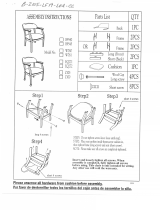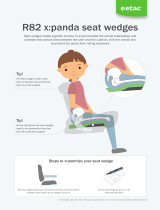
3
Etac / Cross 6 / www.etac.com
Product description:
Etac Cross 6 (Hereafter referred to as Cross
6) is a manual, cross-folded all-round wheel-
chair. Cross 6 offers great possibilities for
customization through settings and cong-
urable parts. Cross 6 is designed for indoor
and outdoor use. Cross 6 has xing points
for transport in motor vehicles. Cross 6 is
intended for reuse.
Intended use:
Cross 6 is designed to be customized to meet
the user’s individual ability and needs.
Intended user:
Cross 6 is intended for users with physical
disabilities. The wheelchair can be used with-
out an assistant if the user can understand
its functions independently and can drive
and brake on their own. The wheelchair is
intended for hand and foot operation.
The design of the wheelchair is based on
adult size users with a body length of 140 cm.
The wheelchair is also suitable for amputees.
The wheelchair is usually not suitable for
small children. The maximum permissible
user weight is stated in the technical data
below. The use of the wheelchair is not limited
to specic diagnosis.
Contraindications:
Users with dementia or cognitive disabilities
should not move in and out of the wheelchair
without assistance.
CE marking, tests:
The product conforms to the requirements
of the Medical Devices Regulation (EU)
2017/745.
The product has been tested and meets the
requirements of EN 12183, which includes
re testing in accordance with ISO 8191-2.
Combination agreement is available, see
www.etac.com.
The product is crash tested at RISE, Research
Institutes of Sweden, according to ISO 7176-19.
The tests have been carried out with clamping
device UNWIN_WWR/ATF/K/R according
to ISO 10542, and with three point strap
907523, Klippan Safety AB.
The tested product was equipped with:
The parking brakes activated
Anti-tip guards activated
Head support mounted with head support
bracket 3A
Handrims on the rear wheels
Service life:
The expected duration and life span of the
main product is at least ve years when
used in accordance with its intended use,
safety instructions, reconditioning manual
and maintenance instructions in the manual.
The main product is covered by seat and back
chassis. Remaining parts/accessories are
handled in accordance with the manual and
reconditioning manual. The actual life span
may vary depending on how much and inten-
sively the product is used, but is a maximum
of 10 years. If the product is intended to be
used after the life span specied by Etac, it
is incumbent on the product owner to ensure
the product’s performance in accordance
with the manual and reconditioning instruc-
tions. If this cannot be ensured, the product
must be taken out of service.
The following surface treatment
methods have been used:
Varnished surfaces = Powder-applied polyester
or ED varnish
Unvarnished aluminium parts = Anodizing
Unvarnished steel surfaces = Galvanized
Warranty:
5 year warranty against defects in material
and manufacture. For conditions,
see www.etac.com.
Customization:
is everything that goes beyond the manual’s
instructions and settings. Wheelchair specially
adapted by the customer must not retain
Etac’s CE marking. Etac’s warranty expires.
If there is any uncertainty regarding the
execution of the customization, consult Etac.
Wheelchairs coupled with another product
may not retain either product’s CE mark
unless combination agreements exist.
Contact Etac for current information.
Reutilization:
Cross 6 can be reused. Follow the instruc-
tions in “Reconditioning instructions, Etac
manual wheelchairs” at www.etac.com.
Etac is continuously improving its products.
We therefore reserve the right to change the
products without prior notice. The dimensions
given in the drawings or other materials are
only indicative.
We will not be responsible for printing errors
and incompleteness.
To be sorted according to
national regulations
Tools
Allen key
3, 4, 5, 6 mm
Box-end spanner
8, 10, 13, 24 mm
Spanner
socket
19 mm
1. General
Symbols and warnings
These symbols appear on labels and in manuals.
Anchoring. Fixing points
for the clamping system
for transport in motor
vehicles.
Tipping hazard: Always
have the anti-tip guard low-
ered when driving.
Detachable part, do not
lift!
2. Safety
General warnings
The following must be taken into account when using the product.
Strong sunlight can heat parts of the chair and cause burns.
When adjusting the seat height, balance position or back
angle, the function of the anti-tip guard must be checked.
Warning: This product can be adjusted beyond safe use.
The prescription of Cross 6 must be done by medical
personnel and tested by a specialist.
The seat can tip over if the backward tilt is greater than 6°.
Use anti-tip guard!
In case of an adverse event occurred in relation to use of the device,
it should be reported to your local dealer and the national competent
authority in a timely manner. The local dealer will forward information
to the manufacturer.





















